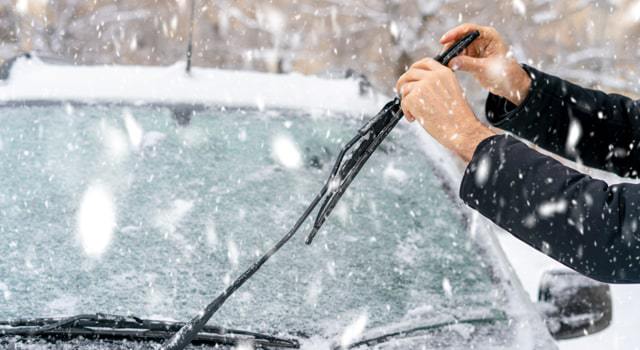The winter months can be harsh on your car. Freezing temperatures and tough road conditions like snow, ice, salt, sand and potholes can take their toll if your vehicle isn’t properly winterized. Fortunately, you can keep your car riding smoothly throughout the season with this winterize car checklist. And if you plan on storing your car over the winter, we have some tips for that too!
Winterize Car Checklist: Driving
Tires
Make sure your tires are in good shape. Low temperatures cause tire pressure to decrease, so make sure they’re inflated to the recommended PSI listed in your manual. While you’re at it, check the tread depth. It’s dangerous to drive on worn tires in slippery conditions.
If you live in an area with regular snowfall, you may consider replacing your all-season or summer tires with snow tires. Snow tires remain flexible and soft in cold temperatures. They’ll improve your car’s handling on snow-covered roads and other slippery surfaces.
Wipers
Winter driving means lots of snow and rain, so take the time to inspect your windshield wipers. If they’re leaving streaks when you use them, it might be time to replace them with a fresh set.
Your wiper fluid is just as important to maintain visibility. Use a wiper fluid with antifreeze to keep ice from forming on your windshield.
Engine
Cold temperatures cause engine oil to thicken, so it’s important to use the right oil grade. Not sure what the right oil is for your car? Simply check your owner’s manual.
While you’re in your engine bay, double check that your coolant is the right ratio for your car. Typically, a 50/50 mixture of antifreeze and water should be sufficient. Again, refer to your owner’s manual for your car’s specific coolant needs.
Battery
The cold can affect your battery life. Many auto parts stores offer quick and free battery inspections. If it’s getting weak, it might be a good idea to replace it. You don’t want to be stranded with a dead battery in the middle of a storm.
Tools
Keep a good scraper and other safety gear in your car. Always scrape off any and all snow from your car. Driving with snow on your car is not only unsafe for you, it also puts others in danger.
Leave a shovel in your car to help dig out of any sudden snow. Rock salt, jumper cables and flares will also keep you prepared.
Wash Your Car
Give your car a fresh coat of wax before the winter season hits and then wash it often. Dirt, salt and other elements can damage your car’s finish. More importantly, the combination of road salt and water is extremely corrosive to steel. It’s a good idea to wash the salt off every few weeks to keep your car rust-free. Make sure you give the underside of your car a good rinse when you do.
Interior
Your shoes can track dirt and salt into your car along with mud. If you live in a snow- prone area, consider waterproof floor mats for your car. They can be custom-made or trimmed for your vehicle; many auto manufacturers offer factory-made ones. Floor mats not only help keep your interior clean, but also prevent water from soaking into your floors, which deters mold or funky smells.
Brakes
Your brake system is one of the most vital safety features of your car. Slowing down on icy or snow-covered roads can be challenging, so it’s important to have your brakes checked by a professional.
Winterize Car Checklist: Storage
If you plan on storing your car for the winter, be sure to do it properly.
Gas
Fuel degrades over time, so use a fuel stabilizer if your engine allows it. Before you start, read your product’s instructions for the right stabilizer-to-fuel ratio. Add the stabilizer when your tank is almost empty, then put in fresh gas. Finally, run the car for about 10 minutes to circulate the stabilized fuel.
Remember to top off your gas before you store your car for the winter. Condensation and moisture can build up in an unfilled fuel tank, which in turn can lead to rust.
Cover
Whether you’re storing your car indoors or outside, a good cover will go a long way. Look for a cover with a fleece interior that’s sized specifically for your car. The better the fit, the better your finish will be protected. Be sure to wash your car before you cover it, as grime can scratch or mar your paint when the cover goes on and off.
Also, be sure to cover up your exhaust pipes and any openings to the interior. These small openings are enticing for critters to climb inside. You don’t want to come back to a chewed wire or pipe.
Interior
If you’re storing your car for the season, give the interior a good cleaning. You may also want to use a moisture absorber, as it can help prevent mold and rust. Check on the moisture absorber and replace it periodically.
Parking
There are a couple things to consider if you plan on parking your car in the same place for a long time. Tires can develop flat spots over time, so be sure to drive your car about every two weeks to keep the wheels in good shape.
In addition, don’t use jack stands to hold your car for an extended period of time. This can bend and damage the frame of your car, which is worse than a misshapen tire.
Battery
The electrical system in your car always draws some power from your battery, even when the car isn’t on. It’s not enough to drain your battery day to day, but over a few weeks your car battery can run out. Disconnect the battery and remember to hook it back up before a drive.
Driving your car periodically over the season will help keep your battery and other systems in your car in shape. If you do have to park your car long term, unplug the battery and hook it up to a car battery tender designed for long-term use.
Outdoor Storage
If you don’t have access to a garage, you may have to store your car outdoors during the winter. When storing a car outdoors, try to park it on a level driveway with the wheels properly chocked. You should also use a heavy-duty waterproof cover and shovel away snow as soon as possible. Finally, avoid leaving your car under a tree or anywhere snow or ice can fall on it.
Don’t wait until after the first snowstorm hits, and don’t forget about insurance coverage. Carrying comprehensive and collision coverage is one of the best ways to protect your car, whether you’re driving or storing it this winter. Our agents at Bender Hatch Insurance can give you more information about comprehensive and collision coverage and determine if it’s the right coverage for your needs. Call us today. (617) 367-4900
Source: https://www.plymouthrock.com/resources/winterizing-car-checklist


